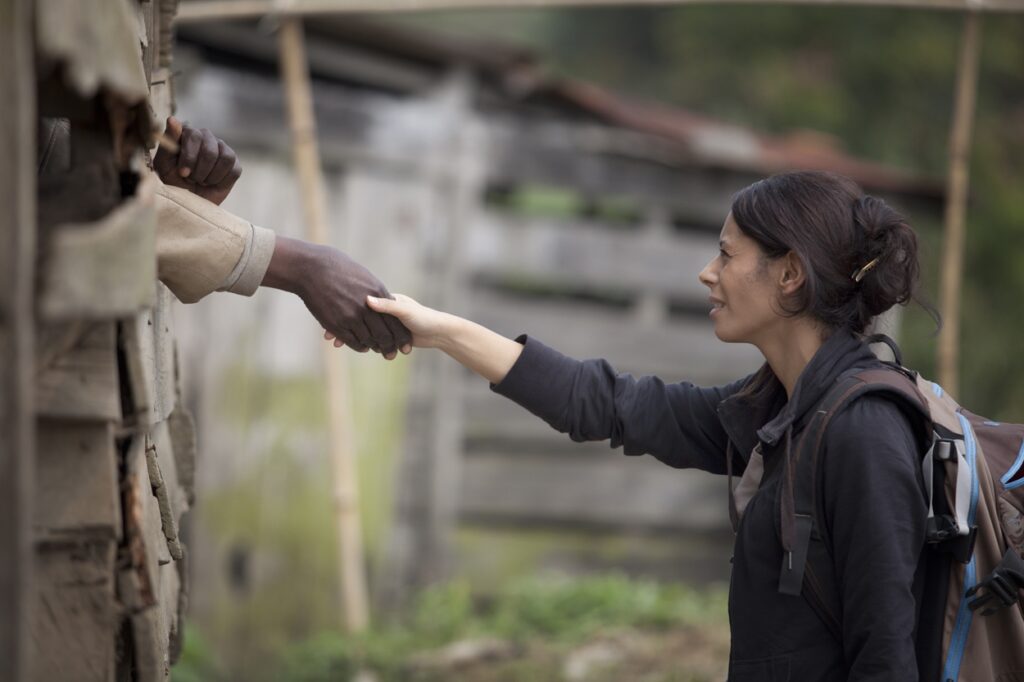Not Enough: Human Rights in an Unequal World
Samuel Moyn
The Belknap Press of Harvard University Press, $29.95 (cloth)
Evidence for Hope: Making Human Rights Work in the 21st Century
Kathryn Sikkink
Princeton University Press, $35.00 (cloth)
“The fact is that human rights law is the law of the elites.” That was the view of Efrén Choque Capuma, a magistrate on Bolivia’s innovative Plurinational Constitutional Tribunal (TCP) a few years ago, as he and his fellow magistrates were charged with the task of constructing the legal-ideological foundations for the new plurinational state.
I had asked Choque why human rights were missing from the country’s vision for revolutionary change, and Choque, who had come from a poor family of Aymara llama and alpaca herders, was not shy about explaining his position.
“The problem with human rights is that they don’t open spaces for generating intercultural justice,” Choque told me. “The other problem with human rights and positive law is that they treat indigenous people like objects, not subjects. But we are our own subjects of law and jurisprudence.”
In tone, outlook, and sense of history, these two books couldn’t be further apart—which is why they must be read together.
Choque’s perspective stuck with me at the time, but it has been especially useful in considering the dueling volumes on human rights by Samuel Moyn and Kathryn Sikkink. Both books entered the field with considerable sound and fury, and, in making their starkly contrasting cases for how and why we should understand the legitimacy and effectiveness of human rights in the present, they also reveal utterly different visions for the future.
In tone, ideological outlook, and sense of history, the two studies couldn’t be further apart. To read them together, as I believe we must, is to consider the place of human rights in global justice as seen by two influential scholars whose orientations lie at opposite ends of the spectrum.
At one end is Sikkink, who is convinced that the international human rights system is our best hope for achieving justice and establishing the conditions for what the Norwegian peace scholar Johan Galtung called “positive peace.” Sikkink believes that the apparent contradictions and difficulties in this system pale in comparison to its demonstrated capacity to synthesize divergent perspectives and unify the global community around a common purpose.
Her volume is optimistic. It rails against the complacency of arid academic critique. It is even explicitly preachy, something she learned from her mentor, the economist and philosopher Albert Hirschman.
At the other end of the spectrum, however, is Moyn, who cannot abide the synthesizing pretensions of the international human rights system. Instead, his vision of human rights is one that focuses on the yawning chasm between aspiration and reality. And because, more generally, it is not in his nature as a critical historian to either justify existing systems or suggest more viable alternatives, he can only chart the topographies of this chasm—as he does, more effectively than anyone ever has—while leaving it to others to figure out how to navigate the dangers.
His volume is pessimistic, disorienting, and infused with regret that such a problematic project for global justice seized the collective imagination. He would agree with Sikkink that human rights promotion has been linked with certain kinds of relative improvements, yet he argues that these only serve to reinforce the “melancholy truth of our failure to invent other ideals and movements” with which to confront the underlying logics of an unequal world.
And yet, as Choque and his Plurinational Constitutional Tribunal show us, ideals and movements not dependent on human rights are being invented, even if these moments of creativity and subversion are taking place far from the centers of economic, political, and intellectual power.
•••
In making her case for both the continuing relevance and significance of human rights, Sikkink’s Evidence for Hope operates on two levels. On the first, her study updates and, to a lesser extent, expands upon her long-term research that measures the existence of “positive human rights trends” and the role that human rights law, institutions, and activist movements have played in shaping these trends.
The link between the two is obviously not causal but it is an important one nevertheless. For example, if it is true that rates of infant and child mortality are generally decreasing—a “positive human rights trend”—this might have nothing at all to do with the work of human rights activists and institutions; indeed, one can imagine a correlation in which such trends occur despite the presence of human rights law and activism.
Is the world becoming a better place? And if it is, is it because of the human rights system?
Yet because Sikkink believes both to be true, her argument requires what amounts to a leap of methodological faith—first, to accept that the world is generally becoming a safer, more equal, and healthier place; and second, to agree that our slowly-but-surely improving world is in large part a legacy of the dogged persistence of the international human rights system, with its many moving parts and scales of action, that was created at the end of the Second World War.
Sikkink goes to great lengths to insist that her argument about the effectiveness of human rights is simply the result of empirical—even if counterintuitive—research. She underscores, time and time again, that the numbers don’t lie, that despite what critics might claim, human rights have played a fundamental role in reducing genocide, decreasing the use of capital punishment, promoting food security and reducing famine, holding dictators accountable for their crimes, and improving access to education, among many other positive global trends. The implication is that empirical human rights researchers have a very different story to tell from those of scholars whose positions are shaped by ideology, interpretive bias, or self-indulgent criticism.
The issue is that the recourse to either what she calls “qualitative comparative case studies” or more straightforward statistics depends on a problematic reliance on human rights indicators. These indicators are produced through complicated measurement systems that often engage in what one colleague has recently described as “commensuration.”
In short, the production of human rights indicators builds on a multilayered process through which the complexities of social life are reduced into categories that can be successively and cumulatively measured. The end result is a final national ranking, which itself can be plugged into a global index of the kind that has become all-too-familiar (for example, I’m happy to report that I currently live in the world’s fifth happiest country, according to the UN’s World Happiness Report).
The problem is that with each act of “empirical” commensuration, what is measured becomes more and more the relationship between measurement categories themselves and less and less the social realties they claim to capture. As various scholars have argued, global indicators—including human rights indicators—have increasingly come to define the boundaries of social and institutional reality itself, since paradoxically what is not measured is not measurable, and what is not measurable does not, in important ways, exist.
Sikkink does not mention this work even to dismiss its critiques. Yet it is not at the level of arguably problematic indicators research that Evidence for Hope really stakes its claims. Rather, the book is a wide-ranging offensive against both criticism of human rights and the most widely read critics of human rights. Sikkink’s counter-attack against the growing disenchantment with human rights is replete with frustration and indignation. Not only do the most visible critics not understand the true origins and effectiveness of human rights, she argues, but their writings have increasingly come to influence the thinking of human rights activists on the frontlines, leading to doubts about the justice of the cause, inaction, and, in the worse cases, despair.
Among the rogues gallery of human rights critics, Sikkink narrows her aim at four in particular: David “The Dark Sides of Virtue” Kennedy, Eric “Twilight of Human Rights Law” Posner, Stephen “The Endtimes of Human Rights” Hopgood, and especially, repeatedly, relentlessly, Samuel “The Last Utopia” Moyn. Indeed, Moyn appears in Evidence for Hope not only as Sikkink’s specific bête noire, but as an ominous specter haunting the international human rights movement itself. In one particularly revealing passage, Sikkink is forced to acknowledge that even prominent members of Amnesty International have fallen under Moyn’s spell, a lapse which brings a reproach for being “too willing . . . to take into account all the criticisms of their enterprise.”
In her sallies against the Four Horsemen of the Apocalypse, Sikkink’s arguments range far beyond the boundaries of empirical observation, leading her into the domains of historical interpretation, rhetorical slicing-and-dicing, and highly questionable social psychologizing. These excursions at times carry Sikkink into murky, troubled waters. For example, as she concludes her “response to the critics,” Sikkink accuses Hopgood of making “venomous statements” in his discussion of former UN High Commissioner for Human Rights Mary Robinson’s interventions in East Timor, perhaps not fully appreciating the irony in the use of historically dehumanizing language in defense of human rights.
For Sikkink, Moyn is an ominous specter haunting the international human rights movement itself.
In what is surely the least convincing section of Evidence for Hope, Sikkink draws from research in psychology to argue that prominent critics of human rights—and their eager readers—suffer from a range of cognitive illusions, which cause them to misapprehend, misinterpret, and deny the truth about human rights. According to Sikkink, critics of human rights show the symptoms of a range of cognitive maladies: futility (believing social change is futile), jeopardy (believing the costs of change are too high), and especially perversity (believing efforts at change produce the opposite). Not surprisingly, on Sikkink’s reading, Moyn is apparently afflicted by all three conditions.
Sikkink is on much firmer and well-established ground while pushing back against the idea that the postwar human rights system was created by the United States and a few Western European countries as a form of cultural imperialism shrouded in the language of universal consensus. She has been among the most determined and convincing advocates for the proposition that politicians and activists from some countries in Latin America played an important role in championing the need for an international human rights declaration in the critical years before the Universal Declaration of Human Rights (UDHR) was adopted by the UN General Assembly in December 1948.
Her focus on the processes that led to the creation of the Organization of American States and the adoption of the American Declaration of the Rights and Duties of Man (which had been drafted in December 1945, three years before the UDHR) lends support to the argument that a concern for international human rights was not limited to a handful of powerful countries during this period.
However, when Sikkink moves beyond the 1940s into the Cold War, her attempt to rewrite the history of decolonization and resistance as a global human rights movement strains credulity. Sikkink is right to highlight recent work by scholars such as Steven L. B. Jensen and Roland Burke that demonstrates the fact that human rights were adopted strategically at different moments, particularly by political leaders with access to international institutions, during the various struggles for independence. But this is a very different thing than to suggest, as Sikkink does, that these comparatively isolated acts of appropriation mean that we should reread the history of decolonization as the first important global human rights movement.
What is almost completely missing from Sikkink’s account is any recognition that the occasional turn to human rights was an exception that proved the much more important rule: that resistance to colonial and neocolonial abuses during the Cold War, despite its diversity, was most often conceived as a revolutionary project inspired by a potent mix of Marxism, nationalism, and antiracism. Among these three, it is Sikkink’s erasure of the inconvenient historical centrality of Marxism and its political and ideological variations—Maoism, Marxist-Leninism, Stalinism, Trotskyism, arguably Latin American syndicalism—that is most troubling.
At one point, her effort to remake the history of Marxist and socialist revolutionary politics into a story of human rights activism even leads her to portray Che Guevara himself as a budding human rights activist most concerned with the development of liberal democracy rather than world communism, the expansion of guerilla warfare, and the eventual violent overthrow of the global capitalist system.
•••
In Not Enough, by contrast, Moyn puts the relationship between human rights, economic inequality, and global political economy at the very center of a study in what he calls the “new human rights history.” The volume builds on his earlier work, including his polemical The Last Utopia (2010), which argued that the human rights movements of today must trace their origins to developments in the 1970s, including the 1975 Helsinki Accords and the embrace of human rights by the ill-fated Carter Administration. That work was met with howls of protest—and dozens of dissenting responses—and it established Moyn almost immediately as a singular critic who detected something foreboding in the eventual rise of human rights as the dominant framework for global justice.
Moyn argues that the evolution of human rights was like a form of genetic engineering in which the very substance of justice-seeking was altered.
In his new book, Moyn takes much of what had remained implicit in his body of historical criticism and makes its explicit. The consequences for both human rights scholarship and our broader understanding of the possibilities for progressive politics and socioeconomic change in the future are significant. Indeed, in this sense, Not Enough makes it impossible to conceive of the current status of human rights in the same way again.
Moyn’s argument is that the evolution of human rights into the prevailing legal, political, and moral response to global problems was like a form of genetic engineering in which the very substance of justice-seeking was altered. According to Moyn, with the promulgation of each new human rights instrument, with each successful international criminal prosecution, and, especially, with the transformation of international development into a form of human rights activism, the terms of global justice themselves were being radically altered. From the French Revolution up through the end of the Second World War, most grand projects for global justice had been concerned with equality, particularly material equality. Yet as Moyn argues, human rights more recently had become a framework par excellence for something quite different: sufficiency.
In other words, the international human rights system became a mechanism for bringing the floor up to a set of lowest common denominators defined in international treaties, human development indices, and highly consequential development “goals.” Human rights were concerned with minimal standards of treatment and provision in a world in which such minimal standards were rarely or unevenly met. The key turning point in this transformation was a set of decisions taken in the 1970s and 1980s by leading development economists such as Mahbub ul Haq and Amartya Sen, who ensured that human rights-based development would forever be guided by the proposition that “it was not worth dreaming about a welfare world that was never going to come to pass,” since “individuals suffer now.”
This profound shift away from global equality toward the fight for global sufficiency was, in Moyn’s analysis, both noble and tragically limited. It was noble in that a world in which treatment and provision minimums would be assured would be a much better world in relative terms. But it was a shift with tragic consequences because it said absolutely nothing about the other side—the ceiling—especially for material provision. And it is here where Not Enough leads the critical and ethical heart to beat much faster.
Because at the same time in which human rights—and thus the possibilities for global justice—were being transformed into our best tools “in a time of downsized ambition,” global inequality was exploding amidst what Moyn calls the “neoliberal maelstrom.” He rejects the simplistic proposition that the international human rights system gave rise to neoliberalism. As he puts it, “neoliberalism, not human rights, is to blame for neoliberalism.” Yet this brings little consolation in the face of what for Moyn is the ultimate dilemma: that “human rights, even perfectly realized human rights, are compatible with inequality, even radical inequality.”
Moyn does recognize that human rights have been concerned with another form of equality, status equality—for example, women’s rights, cultural rights, and, increasingly, LGBT rights—during the years and decades of their ascendance. But on a global scale, the world is still very much marked by pervasive status inequality, in practice if not in law. The crux of the matter is this: the best we can hope for is a world in which human rights realized means a world of sufficiency and status equality against a backdrop of vast material inequality. As Moyn puts it, this would still leave us with a world that was “destined to instability and ruin.”
Even so, Moyn does not exactly tell us why global inequality itself is the foremost, organizing evil from which “humanity must save itself.” His analysis remains vague on this point, suggesting both that “galloping” inequality in the face of “basic rights and needs fulfilled” is immoral and that such a fundamental contradiction will have horrendous, even if unspecified, future consequences.
But even if Moyn hasn’t specified the disease in clinical detail, let alone prescribed a long-term treatment, others certainly have. One need only turn to the conclusion of Thomas Piketty’s Capital in the Twenty-First Century (2014), in which the future, real-world implications of a single, absurdly simple equation, r > g, are imagined. Piketty describes a “terrifying” global political economic tsunami in which the institutional engines of private capital—and the powerful nation-states that do their bidding—continue to expand and accumulate at dizzying rates, while real economies, comprised of output and wages, churn along or stagnate. And there is no way out of what he calls the “central contradiction of capitalism” from within the system itself. As Piketty puts it, “once constituted, capital reproduces itself faster than output increases. The past devours the future.”
•••
This brings us back to Sikkink’s and Moyn’s clashing visions of the place of human rights in the midst of our perilously unfolding present—and it brings us back to Bolivia.
Global justice requires that we look away from Geneva and New York to the outer fringes of global power.
For Sikkink, human rights are effective yet imperfect tools that have played an important role in making the world less unjust than it would have been otherwise. For Moyn, the structural defects in human rights law and institutions mean that these advances, which at their most expansive have consisted in “sensitizing humanity to . . . misery,” are advances along a path that is itself fundamentally misdirected.
Yet the quiet revolution taking place in Bolivia is happening along a different path entirely. Bolivia has ideologically and legally “refounded” itself as a post-neoliberal state committed to radical pluralism and the promotion of national welfare. Based on an innovative mix of state-controlled economic redistribution, the political empowerment of historically excluded populations, and an assertive nationalism, the country has been transformed in less than fifteen years.
In a sense, this transformation has also been a form of opting out of the “neoliberal maelstrom”—or, the very least, riding higher along its edges. For the time being, it has nothing directly to say about the maelstrom itself. Efrén Choque, the indigenous Bolivian magistrate, was quite conscious of the fact that his country’s experiment makes no pretensions to universality; it doesn’t claim membership in the collective first person suggested by Moyn’s “our failure.”
Which perhaps is the broader lesson here: if we are really interested in moving from melancholy to the pursuit of new forms of global justice marked by high, rather than low, ambitions, it should not be to Geneva or New York or Beijing that we should look. Rather, it should be to the borders, to the margins, to the few remaining places that global capital has largely left behind.
Perhaps it is there, somewhere along the outer fringes of global power, that the seeds of a viable and enduring response to our engulfing contradictions are to be found.








